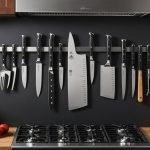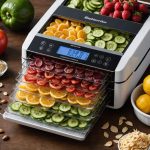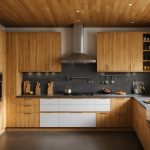Overview of Magnetic Knife Strips
Magnetic knife strips are essential tools that help achieve both kitchen organization and culinary safety. These strips are designed with powerful magnets to hold knives securely against a wall or another flat surface. By keeping sharp blades off the counter or out of drawers, they not only reduce clutter but also enhance safety.
In the realm of kitchen organization, magnetic knife strips offer a sleek and accessible storage solution. They allow for easy visual identification of tools, ensuring that chefs can effortlessly select the right knife for the task. Moreover, by hanging knives in open sight, magnetic strips save valuable space, particularly in smaller kitchens where countertop or drawer space may be limited.
Also to discover : Mastering flavor: your comprehensive handbook for choosing the perfect food dehydrator to preserve nutrients
Safety is a paramount concern in any cooking space. By using a magnetic knife strip, the risk of accidental cuts from rummaging through drawers is minimised. Additionally, the strips help maintain the sharpness of your knives by keeping blades from clashing against other utensils.
The benefits of magnetic knife strips are ample: they improve kitchen organization, support culinary safety, and add an element of modern design flair. Selecting the right magnetic knife strip can transform your cooking area into both an efficient and aesthetically pleasing environment.
Have you seen this : Mastering soft-boiled eggs: your ultimate guide to selecting the perfect egg timer
Safety Features of Magnetic Knife Strips
Magnetic knife strips are an elegant solution for ensuring knife safety in your kitchen. One of their primary benefits is reducing the risk of accidents. By keeping knives visible and securely anchored on a strip, the chances of inadvertently cutting oneself while rummaging through a drawer are minimized. This is especially useful in busy kitchens where distractions are common.
The visibility of knives on a magnetic strip also allows for safe and easy access. When knives are visible at a glance, you can quickly identify and pick the right tool for the job, significantly reducing the likelihood of mishandling. This easy accessibility becomes increasingly beneficial when cooking under time constraints or with multiple kitchen tasks at hand.
Compared to traditional knife blocks, magnetic strips offer superior safety features against kitchen hazards. Knife blocks can hide sharp blades, making it easier for fingers to inadvertently come into contact with them. They also can trap moisture, which may lead to rust and degrade the blade’s integrity over time. In contrast, knife strips promote airflow around the blades, assisting in maintaining their quality and reducing the risk of harbouring bacteria.
Thus, magnetic strips present a safe and practical method to manage your knife collection, keeping both the cook and the kitchen environment safe.
Organizational Benefits
Maximizing kitchen space optimization can transform the functionality and flow of your cooking area. One practical solution is the use of magnetic strips. These space-saving tools can be mounted on your walls to keep metal utensils like knives and scissors conveniently accessible, freeing up drawer and counter space.
Implementing magnetic strips is a step toward decluttering. By lifting items off the countertop, you create a clutter-free kitchen environment that not only looks tidy but also fosters a more efficient workspace. This arrangement supports a smoother cooking experience by providing everything you need within arm’s reach.
Moreover, magnetic strips offer a form of ergonomic storage that promotes convenience. When tools are mounted at eye level, you reduce unnecessary bending or stretching, making cooking tasks more comfortable and less strenuous. This setup can save time and effort, especially during complex cooking sessions where quick accessibility to tools is paramount.
In summary, utilizing magnetic strips is a simple yet effective strategy for improving kitchen organization. Their ability to optimize space, encourage decluttering, and enhance ergonomic accessibility ensures that your kitchen is not only functional but also a pleasure to cook in.
Usability and User Experience
Exploring the user-friendly design of magnetic knife strips reveals how they enhance the efficiency of a kitchen workflow. These strips allow for easy access to knives, ensuring a seamless cooking process. Users consistently report how quickly they can grab the correct knife, reducing cooking time and enhancing safety as knives are organised and visible.
Hands-on experience with such strips highlights their effectiveness. Users often note how these tools keep counters uncluttered, providing more space for preparation tasks. Additionally, many appreciate the visual accessibility, allowing cooks to maintain focus on their recipes rather than rummaging through drawers.
What’s the actual ease of use like? Feedback shows that mounting a magnetic knife strip is straightforward, and removal or adjustment of knives is smooth. This practicality means these strips appeal to both amateur cooks and seasoned chefs.
User testimonials consistently praise how magnetic strips blend function with style. Many users enjoy how these strips complement kitchen aesthetics, adding a touch of elegance while remaining tremendously practical. One user mentioned, “It transformed my cooking habits. Grabbing a knife became second nature,” demonstrating the profound impact on their culinary routine.
Whether it’s speeding up meal prep or improving kitchen organisation, magnetic knife strips are proven assets in any kitchen setup.
Installation Tips
Mounting a magnetic knife strip can streamline your kitchen workflow, but executing a proper installation is crucial for safety and efficiency.
Step-By-Step Guide for Mounting:
-
Choose the Location: Begin by assessing your wall space. A location near your food preparation area is ideal, balancing accessibility with safety.
-
Decision on Mounting Type: Depending on your kitchen’s wall surface, choose a suitable mounting technique. For drywall, opt for wall anchors to ensure stability. For wooden surfaces, screws are typically sufficient without anchors.
-
Mark the Wall: Use a level and pencil to mark the positions for screws or anchors to ensure your installation is straight.
-
Drilling and Attaching the Strip: Carefully drill holes at the marked positions. For drywalls, insert wall anchors first. Screw the magnetic strip into place firmly.
Before mounting, evaluate if your wall type—be it tile, drywall, or wood—requires specialized mounting techniques or tools. For instance, tiles often need a carbide-tipped drill bit to avoid cracks.
Tips for Choosing the Right Location:
- Ensure the strip is out of reach of small children.
- Keep the strip’s alignment with adjacent kitchen elements for aesthetic coherence.
Wall Type Considerations:
Tailor your technique to your kitchen’s wall materials. Drywalls need careful handling to avoid damage, while wood offers more forgiveness. Adjusting tools and fixing methods to align with wall characteristics guarantees both security and longevity of the installation.
Comparison to Traditional Storage Methods
When it comes to knife storage options, understanding the pros and cons is crucial for making an informed decision. Let us delve into the differences between magnetic strips and knife blocks, drawer storage, and the impact on hygiene and maintenance of these kitchen tools.
Magnetic Strips vs. Knife Blocks
Magnetic strips offer a modern appearance and save counter space by mounting on walls. They make knives more visible and accessible while showcasing them elegantly. However, their exposure can lead to dust accumulation, necessitating regular cleaning. Knife blocks, on the other hand, are more traditional. They provide a protective enclosure for knives, reducing the risk of unintentional contact. Yet, they occupy counter space and can trap moisture, affecting knife longevity.
Drawer Storage vs. Magnetic Strips
Drawer storage maximises counter space, keeping the kitchen clutter-free. However, this option can lead to knives clashing, risking dullness, unless equipped with an organiser. Magnetic strips prevent such clashes, maintaining knives’ sharpness. Nonetheless, drawer storage can offer a cleaner, hidden look for those valuing aesthetics over immediate accessibility.
Hygiene and Maintenance
Knife blocks require thorough cleaning to prevent bacterial growth. Magnetic strips demand regular dusting but generally ensure superior aeration. Drawer storage may necessitate additional care to avoid scratches and maintain ease of access. Evaluating the hygiene demands of these options aids in selecting the most suitable for your lifestyle.
Expert Opinions and User Testimonials
Understanding the importance of kitchen safety and organization is crucial for every household. Expert reviews consistently highlight the benefits of effective kitchen practices, emphasising not only aesthetics but also safety. For instance, safe knife storage and organisation are often linked to reduced risks of accidents. Studies have shown that clear organisation can decrease the rate of knife-related accidents by up to 30%.
Expert Insights on Safety and Organization
Safety specialists underscore the necessity of proper storage solutions. Organised kitchens lead to easier access and reduced clutter, significantly lowering the risk of accidents. The placement of tools in easy-to-reach and visible spots is frequently recommended by experts.
User Feedback
User testimonials provide a real-world perspective on these safety measures. Many users report feeling more confident and less stressed when their kitchens are well-organised. Stories of avoided mishaps thanks to proper planning are common. This feedback highlights the personal impact of safe kitchen practices.
Statistical Evidence
Robust statistical evidence supports the need for efficient kitchen organization. Research consistently reveals that organised kitchens not only improve safety but also enhance efficiency and workflow, suggesting that even small improvements in organization can have a significant impact on daily kitchen operations.











